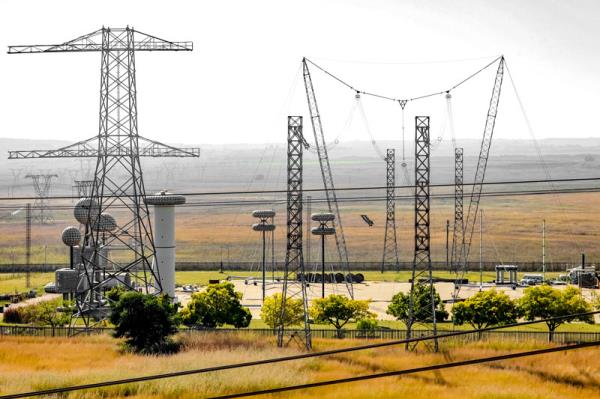03 June 2024

Africa’s utilities providers are going smart with wireless technologies, enhancing reliability and cutting costs with a combination of terrestrial and satellite connectivity…
When we talk about connecting Africa, we’re usually focusing on consumers – enhancing internet adoption, enabling new services like OTT, mobile money, telemedicine, mobile retail, and so on. However, enterprises, too, stand to gain hugely through the provision of wireless connectivity, from e-governance projects through to one of Africa’s most challenging critical services – utilities.
In support of utilities
Wireless communications have proven instrumental in supporting the provision of utilities across Africa, and, of course, the world at large.
“On average, electricity utilities in the continent lose 23% of all energy consumed due to operational inefficiencies, at a cost of almost US$3.3 billion per year, compared to a 10% global average,” reports Nabil Ben Soussia, group CCO, IEC Telecom. “Africa is struggling with huge operational inefficiencies estimated to be costing more than US$3 billion annually. This contributes to the region suffering the world’s highest energy prices, with most of its electricity providers barely breaking even, which limits their scope for reinvestment.”
“Over the past few years, African utilities – especially of the electric variety – are making impressive strides to both modernise their grids and expand services to more underserved areas than ever before,” adds Dori Erann, VP, private networks marketing, Ceragon Networks.
Indeed, smart grid systems are becoming huge on the continent, helping enhance the reliability and efficiency of electricity distribution. These smart grids utilise sensors, meters, and communication networks to gather data on energy consumption patterns, identify areas of high demand, and manage power distribution more effectively, enabling reduced energy losses, lower operational costs, and improved service quality – particularly important goals for a region blighted by significant power outages.
“Receiving real-time data on the grid’s status and operations can help drive further provisioning of services,” outlines Erann. “With the right data at their fingertips, utilities can go beyond day-to-day monitoring and management, and use data and artificial intelligence (AI) for predictive analytics as well as preventive and corrective maintenance.”
Remote monitoring and control of essential utilities infrastructure – power grids, water systems, oil pipelines, etc. – makes a significant positive contribution to optimising scant resources. Moreover, with this remote monitoring, utilities operators can properly monitor their operations no matter how remote or rural the site, without having to send a human engineer for monitoring and maintenance – a task which may take days, lack accuracy, and be price-prohibitive.
“With this fast-paced growth and modernisation, planning, deploying, and running a resilient, reliable, and high-speed communications network backbone is vital. The right network enables key applications that can significantly advance and improve a utility’s business operations and overall efficiencies,” says Erann. “Whether it is connecting remote field personnel, adding video surveillance to secure people and assets, or incorporating next-generation technology such as smart sensors, IoT devices, distribution automation, or AI, having sufficient and ubiquitous connectivity is the key to a utility’s growth in the modern world.”
Modernising the network
There is no one magical technology for utilities when it comes to an expansive continent like Africa - the best communications solutions usually include a combination of many.
Microwave backhaul, for instance, can bridge long distance gaps, while WiFi offers hotspots for IoT, field personnel, and fleet vehicles. Wireless smart utility network (WI-SUN) and RF-mesh can connect smart meters, while LoRaWAN and Zigbee can connect IoT sensors and devices. Private LTE/5G has an increasingly important (and increasingly profitable for providers) role to play in connecting multiple locations with high-speed, secure connectivity.
“The ideal utility network is quite complex and varies from one geography to another. Much of utilities’ existing infrastructure is becoming obsolete, and they need to begin considering upgrading, introducing a larger challenge - to develop a modernisation plan as early as possible,” says Erann. “This digital transformation journey should consider all technologies, trends, applications, and future needs to ensure that the investments made today are being applied in the most practical and effective manner.”
For remote and rural regions, home to many utility services, terrestrial infrastructure is limited at best, thus satellite is a necessary enabling technology, providing access to critical data, communication, and remote monitoring capabilities, supporting operations in challenging environments.
“Connectivity enables the utility sector to easily shift from reactive response to preventive management,” says Soussia. “Satcom data inputs feed into the comprehensive web platform, which is equipped with a pre-set alert mechanism to identify potential threats. As a result, a serious breakdown can be avoided with timely maintenance.”
Meanwhile, with 90% of fresh water in Africa found within 63 international river basin catchments crossing multiple borders, water resource management on the continent must be an inherently international and cooperative endeavour. This is a challenging task considering the technological gaps between African countries, as well as geopolitical tensions within the continent.
“Projects such as Cooperation in International Waters in Africa (CIWA) aim to resolve this utility challenge by harnessing the power of remotely sensed (RS) satellite data,” reveals Soussia. “RS data is used as input for a range of analytical tools, such as flood forecasting, monitoring of surface water quality, tracking water diversion and allocation, and quantifying water storage in reservoirs. Satellite-derived data offers undeniable technical advantages by standardising instrumentation requirements, effectively bridging the technological disparities across Africa. Moreover, its politically neutral nature fosters transparency in data sharing across borders.”
Satcoms are also proving invaluable in supporting a remote workforce since, “while RS data offers the visibility necessary to run industry assessments and raise the red flags to be addressed, we still require humans to manage, maintain and expand utility networks. Satcom is vital for remote workers to keep in touch and call for help if needed,” explains Soussia. “By empowering remote workers with reliable connectivity, utility organisations can improve the coordination of maintenance operations in far-away areas. Using tools like smart goggles and real-time communication, remote workers can leverage the expertise of technical staff based in HQ, which can enable them to resolve problems and accomplish more tasks over one visit.”
Soussia highlights an interesting story wherein a team of researchers from the International Institute of Applied Systems Analysis (IIASA) and the Future Energy Program at the Fondazione Eni Enrico Mattei (FEEM) in Italy analysed the precision with which satellite images showing nighttime lights could be converted into spatially detailed maps of electricity access in sub-Saharan Africa.
“The research validates a growing recognition of the potential gains of using satellite data to assess the availability of electricity across a large geographical area,” asserts Soussia.
Digital twins, too, have a significant role to play when it comes to modernising utility networks globally. A digital replica of the utility’s physical assets and systems can be used strategically to monitor, control, and optimise every corner of the utility, in real time.
“From strategic planning, modelling, testing, performance monitoring, to automated equipment upgrade notifications and a single source of truth for employees alike – implementing a network digital twin can pay out enormous dividends in the long run,” says Erann.
By combining the right technologies for each specific application, challenges related to critical infrastructure can be overcome to improve the reliability and efficiency of utility services and accelerate progress towards achieving universal access to essential utilities.
Moreover, “with the right equipment, tools, and know-how baked into their plan, utilities can avoid pitfalls such as trying to manage multiple, disparate networks which tend to result in bottlenecks, network vulnerabilities, and typically require additional inhouse personnel and expertise,” asserts Erann.
A wireless future
No technology is without its shortcomings, of course; while wireless communications offer numerous benefits to the utilities sector, they also come with challenges compared to their wired counterparts, namely reliability, bandwidth limitations, security concerns, coverage, interference, and congestion.
However, industry marches on, and advances like 5G, IoT and satcoms, and ongoing improvements to all aspects of their application, continue to offer extremely attractive benefits for utility operators. Moreover, while fibre plays an important role in connectivity everywhere, it too has its limitations.
“Many African countries face large geographical expanses and long distances where digging and laying fibre is both time consuming and cost prohibitive. In addition to long distances, obstructions such as waterways, mountains, and other topologies can create serious issues for fibre deployment,” says Erann. “By utilising wireless connectivity, utilities can get their entire grid – people, assets, and places – connected in a fraction of the time and costs associated with all-fibre deployments. While wireless has its own challenges – licensed vs unlicensed operations, attaining enough spectrum, regulatory issues, etc. – these problems are often easier and more affordable to solve than those posed by deploying ubiquitous connectivity with fibre.”
Wireless communications, therefore, are likely to continue to play a pivotal role in driving innovation, improving efficiency, and expanding access to essential utility services across Africa. Looking ahead, we can expect to see further investment in smart grids, IoT solutions, and satcoms integration, as well as a heightened focus on cybersecurity, sustainability, collaboration, and public-private partnerships.
Soussia reports that the use of satellite technologies within the utilities sector is also growing and set to bring even greater benefits in terms of operational efficiencies.
“With the introduction of the low Earth orbit (LEO) satellite constellations with their low latency, large bandwidth, and high-speed connectivity the opportunities are expanding. With the development of specialist software and applications it is now possible to conduct activities such as real-time surveillance, video conferencing, and data management in even the most remote areas. And watch this space – the satcom industry is developing at such a rapid pace that within only a few years what is possible will be transformed,” announces Soussia.
Wireless communications in Africa’s utilities sector are poised to undergo significant transformation, driven by technological advancements, changing consumer expectations, and evolving regulatory frameworks.
“There are billions of dollars to be invested over the next decade in advancing and expanding utility services – especially in the sub-Saharan region,” asserts Erann. “By leveraging wireless technologies, utilities can overcome geographical barriers and serve remote or underserved areas with essential services such as electricity, water, and telecommunications. The flexibility and scalability of wireless communications enable utilities to extend their reach to a broader customer base, thereby contributing to an improvement of life and socio-economic development across the continent. An advanced communications network enables utilities to optimize resource management, detect and address issues promptly, and improve overall service quality. This, in turn, fosters sustainable development, ensures equitable access to essential services, and supports the growth of infrastructure in previously underserved regions of Africa.”






